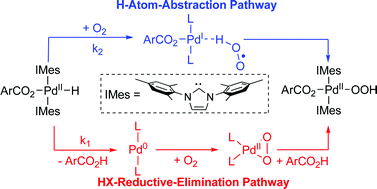O2insertion into a palladium(ii)-hydride bond: Observation of mechanistic crossover between HX-reductive-elimination and hydrogen-atom-abstraction pathways†
Abstract
The reaction of molecular oxygen with palladium(II)–

* Corresponding authors
a
Department of Chemistry, University of Wisconsin-Madison, 1101 University Avenue, Madison, Wisconsin, USA
E-mail:
stahl@chem.wisc.edu
Fax: +1-608-262-6143
Tel: +1-608-265-6288
The reaction of molecular oxygen with palladium(II)–

 Please wait while we load your content...
Something went wrong. Try again?
Please wait while we load your content...
Something went wrong. Try again?
M. M. Konnick, N. Decharin, B. V. Popp and S. S. Stahl, Chem. Sci., 2011, 2, 326 DOI: 10.1039/C0SC00392A
To request permission to reproduce material from this article, please go to the Copyright Clearance Center request page.
If you are an author contributing to an RSC publication, you do not need to request permission provided correct acknowledgement is given.
If you are the author of this article, you do not need to request permission to reproduce figures and diagrams provided correct acknowledgement is given. If you want to reproduce the whole article in a third-party publication (excluding your thesis/dissertation for which permission is not required) please go to the Copyright Clearance Center request page.
Read more about how to correctly acknowledge RSC content.
 Fetching data from CrossRef.
Fetching data from CrossRef.
This may take some time to load.
Loading related content
